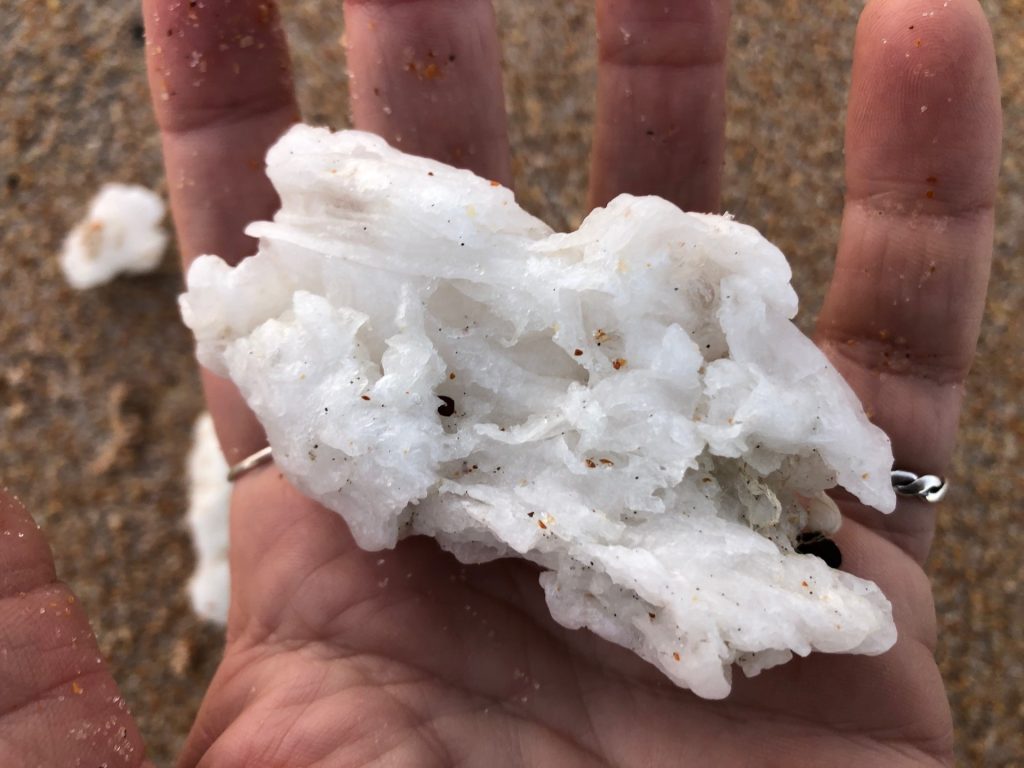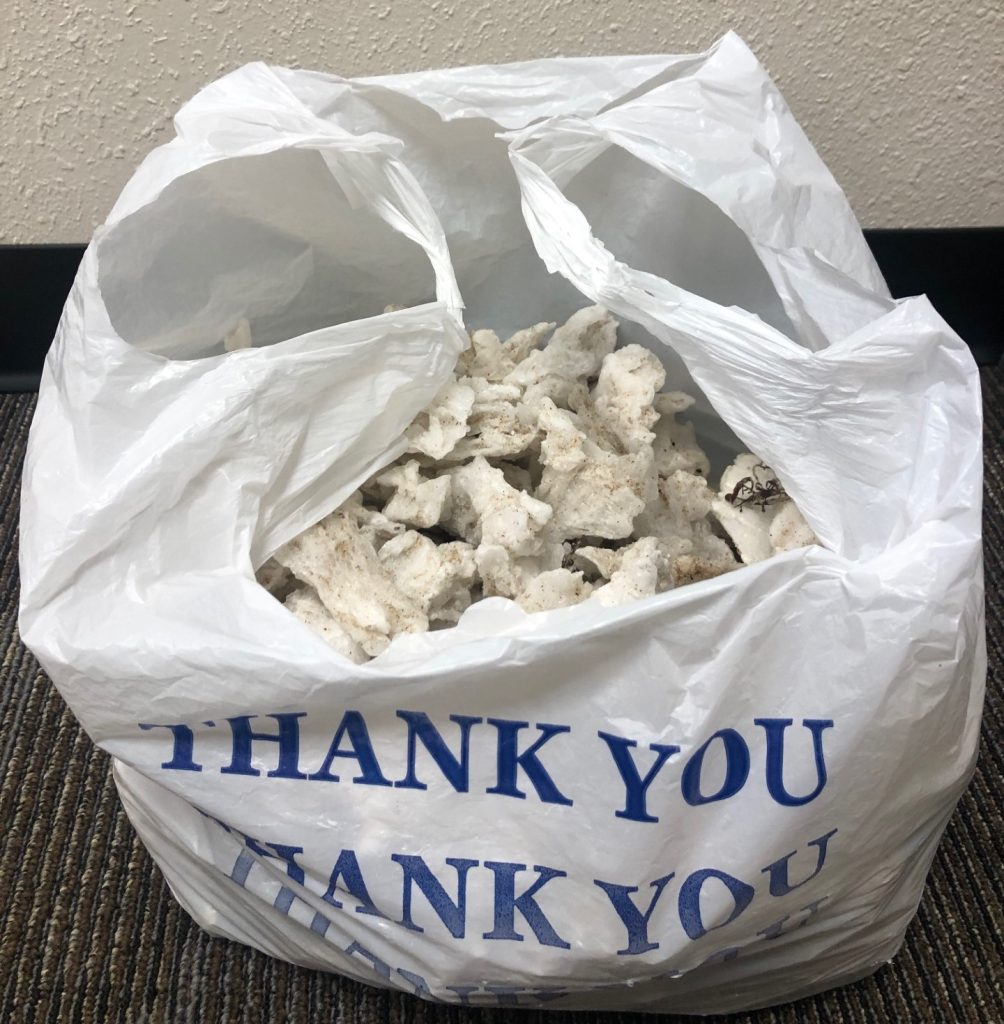We had some big waves in mid-December, and with that washed up a slew of plastic fragments and bottle caps as well as natural debris such as sargassum seaweed and black mangrove propagules. However, there was something different on our beaches as well – blobs of a white, waxy material. This was new to me, and so I went on a deep dive into what it could be.

So, what is that white wax on the beaches?
Long story short, the lumps of wax are most likely paraffin wax. 
What is paraffin wax?
Paraffin wax is known as a petroleum wax as it is a type of wax naturally occurring in crude oil. German Chemist Karl von Reichenbach figured out how to separate the wax from the petroleum in 1830, and before long it became an important base for candles. Paraffin wax is used in a variety of products now, including candles, crayons, beauty products, and as lubricant or insulation for electrical components. Other petroleum waxes include microcrystalline waxes and petroleum jelly.
How did paraffin wax end up on our beaches?
Again, long story short: paraffin wax is washed out of tanks of ships that it was held in during transport between ports.
Huh? Keep reading…
Petroleum waxes are transported around the world in cargo ships and tankers. They are often heated so that they can be loaded or discharged in their liquid form. After the liquid wax is unloaded, some of the material remains in the tanks or gets stuck to pipes. The tanks are then cleaned, removing the leftover oil or wax via steam, hot water, or chemical solvents – this process is sometimes referred to as “stripping.” The residual material may be treated by a facility in port, but they may also be released at sea under certain conditions.
The International Convention for the Prevention of Pollution from Shops (MARPOL) Annex II determines which materials can be discharged at sea under what conditions. Petroleum waxes fall into a category Y, which is a moderate pollution level – the release isn’t totally banned but is regulated. Ships should empty their tanks to the maximum extent possible, prewash and discharge the residue at a reception facility, and then if a second wash is needed, they can legally discharge at sea if they are at least 12 nautical miles from land.
Whew, I know that is a lot of technical speak, but basically these waxes (and other oils such as palm oil) can legally be released in certain quantities in the ocean if they are 12 nm from shore. In the case of large quantities of wax, it is also possible a ship did not follow the pre-wash regulation and disposed of all its residual material at sea. Unfortunately, it is very difficult for us to know the exact source of the wax, and we will not likely be able to find the specific ship or disposal location. However, it likely came from quite far out at sea and was washed in with the large storm event and waves that we experienced in mid-December. While mass washups of this wax has been reported in several locations in Europe in the past, there are very few records of such events on the coasts of the United States.
I heard it was palm oil. How do we know it is paraffin wax and not palm oil?
While we haven’t had the waxes chemically tested and so we cannot say anything with 100% certainty, the evidence points to paraffin wax. Primarily the fact that palm oil has a melting point of about 95 degrees Fahrenheit, and paraffin wax melts between 115 and 155 degrees Fahrenheit. The wax on the Florida beaches in December 2023 has a melting point of approximately 130 degrees Fahrenheit, falling within the range of paraffin waxes. Both paraffin and palm oil have been reported washing up on beaches in different parts of the world (primarily Europe) and enter the ocean through the same process. The melting point as well as white color and crumbly texture are what make me believe we are currently dealing with a paraffin wax.

Is this wax bad for the environment?
The rate of biodegradation of paraffin waxes is currently unknown and depends on the presence of various bacteria or fungi that can break it down. The wax easily breaks into smaller pieces and so the remains will become smaller, but it will likely persist in some form in the environment for at least several years, if not longer. Paraffin-like waxes have been reported in the stomachs of several species of seabirds and a stranded juvenile loggerhead sea turtle. Therefore, it is encouraged to clean the beaches of this wax as we would for any other trash. Always take care when cleaning debris off beaches for any sharp objects and wash your hands with soap and water after handing any debris.
If it is paraffin wax, can I use it?
Although paraffin wax is used in many products, it is not recommended to use this wax for any products. Why? There are many grades of paraffin wax that reflect their level of processing and we do not know the specifics of this wax. In addition, the wax is not pure. Much of the wax has both natural debris such as sand as well as human-made debris such as plastic fibers embedded in it, and it is unknown if any other compounds are mixed with the wax. The best bet is to remove it from the beaches and dispose of it in a trash bin.

Have you seen paraffin wax on the beaches in Florida?
Most previous records of paraffin and petroleum waxes on beaches comes from Europe, and there is little documentation of such events in the United States. The observations that spurred this article were made based on wax collected at beaches in Volusia County on December 27, 2023. Wax was first observed in this area on December 15, 2023. If you have any additional information that you believe would be helpful in understanding this event (including sighting of the wax in other areas of Florida during this time frame) or any questions, please reach out to Florida Sea Grant Extension Agent for Volusia and Flagler Counties Carolyn Kovacs at c.kovacs@ufl.edu.
If you are interested in learning more:
I recommend reading The Occurrence of Paraffin and Other Petroleum Waxes in the Marine Environment: A Review of the Current Legislative Framework and Shipping Operational Practices by Suaria et al., which was my primary source for this article.
 19
19
